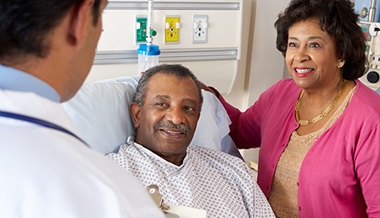Early-Stage Stomach Cancer Treatments
Reviewed By:
Early-stage stomach cancer can be a silent threat, often causing few or no symptoms until the disease has grown into advanced stages and is more difficult to treat. However, doctors are diagnosing (and treating) stomach cancer earlier and more often than ever, thanks in large part to advanced endoscopic tools. An endoscope is a flexible tube with a light and camera attached to it.
Johns Hopkins gastroenterologist Saowanee Ngamruengphong, M.D., explains how endoscopic resection (removal) procedures treat early stages of stomach cancer.

Treating Early-Stage Stomach Cancer
“Endoscopic resection is now the standard treatment for early stomach cancer, when the chances that the disease has spread to the lymph nodes are very low,” says Ngamruengphong.
In endoscopic resection, patients are sedated for their comfort and safety. The endoscope allows the doctors to clearly see inside the body. Doctors pass the endoscope down a patient’s throat and to the affected area. Using specialized tools and techniques, they remove the early-stage cancer.
Doctors use these two types of endoscopic resection procedures to cut away the cancer from the stomach lining:
- Endoscopic mucosal resection (EMR)
- Endoscopic submucosal dissection (ESD)
EMR is widely available in the United States. “We have been performing this procedure for the past 10 years,” Ngamruengphong says.
Comparatively, ESD uses much newer techniques that allow doctors to remove the lesion in one piece. Analyzing the lesion in one piece helps pathologists learn more about the cancer so they can develop more targeted treatments. ESD also often results in a lower chance of the stomach cancer coming back (recurring).
Because these techniques are so new, fewer specialists are trained in (or have extensive experience) performing the technique. Training is key, says Ngamruengphong. “This procedure leads to better results but is more time-consuming and difficult to perform,” she says.
Endoscopic Stomach Cancer Treatment Benefits
Doctors use both endoscopic resection and traditional surgery to provide effective stomach cancer treatment. During a traditional, or open, surgical resection, surgeons make an abdominal incision to access the stomach and remove all or part of the stomach as well as affected lymph nodes and tissue.
For patients with very early disease, Ngamruengphong says the less invasive endoscopic resection can treat stomach cancer as safely and effectively as traditional surgery — with multiple added benefits.
Patients who are candidates for an endoscopic resection can experience:
- Less pain after the procedure
- A shorter hospital stay
- A shorter recovery
- Similar survival and recurrence rates to surgery
Every cancer presents — and acts — differently. If you’ve been diagnosed with stomach cancer, your doctor can help you determine which treatment approach is best for you.






